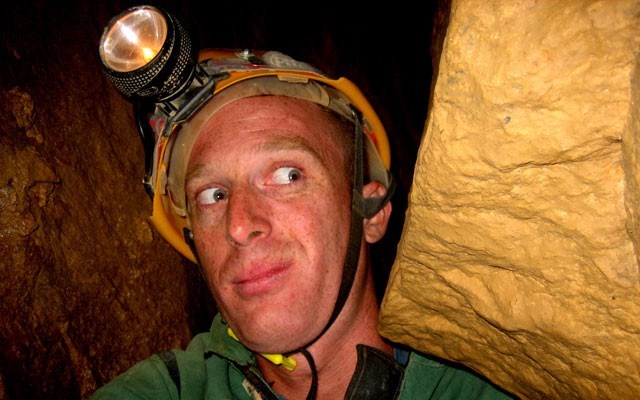There is a technique to squeezing my body through this sliver in the rock wall. It involves thrusting myself forward in full stretch, using my left arm to support my body, and vibrating myself towards the bend. Here, my right hand will hopefully find a grip to pull myself around the corner, taking care not to slip to the bottom, where I could be wedged in and join the unfortunate club of "Stuckies." As I pretzel into position, dust glittering in the beam of my headlamp, it's hard to believe I'm just metres below the streets of Budapest.
Millions of years ago, a sea flowed beneath the Hungarian capital, creating a vast network of caves and underground wells that feed the city's famous thermal baths. In Buda, split from Pest by the mighty Danube, it is possible to explore these caves with Barlangaszhat, an underground tour operator that takes its description literally. Their caving adventures are primarily marketed as corporate team building, and also to backpackers, who presumably are considered skinny enough to slip through the cracks. The Matyeshegy Caves are located about twenty minutes by bus from downtown, and although the system was used as a bomb shelter for citizens in World War II, it is closed to the general public.
Making its way through soft limestone, the caves extend for miles beneath the city, although my three-hour adventure would only cover a mere 800 metres.
My guide Kata unlocks a thick iron door, checks the headlamps of our small group, and ushers us in. The door thunks ominously, and the darkness and silence is immediate.
Budapest's boulevards may as well buzz in another solar system. We descend about ten metres down a cold, rusted iron ladder, and the challenge begins.
Don't get lost, don't get stuck.
Moving ahead in single file, it is crucial to maintain contact with the person in front, and the person behind. Spelunking is all about teamwork, as the leader has to explain how to go about negotiating the thin crack that is the next doorway. Broken telephone could result in lost and panicked tourists, or even broken bones.
After a few tight passages, we gather in a large cavern. "Can anyone guess where we go next?" asks Kata. Swivelling my neck, I see five possible exits we could squeeze through. Naturally, she points to a sixth — a fracture beneath her feet. Like a game of Twister, she explains how to proceed, slides on her back, and quickly disappears beneath the rock.
With disbelief I began to follow, grunting and groaning as I squash my body into the required position. What follows is a series of contortionist obstacle courses, many of which require me to lie flat, sandwiched between the moist limestone, and worm my way out. In a room that graciously allows us to sit upright, we decide to see what happens without any light. Our group of nine turns off our headlamps, with Kata extinguishing her gas-fuelled flame. Instantly we embrace a darkness and fear so thick I could taste it. Deep underground, with no light whatsoever, it is natural for your eyes to play tricks on you as they try to adjust to absolute nothing. I see fractals and kaleidoscopes, demons and angels. Notwithstanding the complicated procedures needed to navigate this far, if you got stuck down here without a light, the despair would be overwhelming. For even without the fire and brimstone, there is a reason hell is below us. Lights get switched back with a sense of relief, and onwards we trod.
At the final challenge, safety helmets are removed because they cannot fit through the hole. I am re-entering an earthly birth canal, sucking my gut in, budging myself inch by inch. At one point, I become lodged in tight, cursing the consumption of good, cheap beer and those damn perogies. Thrills lie in those few precious moments when my nerves become stuck, my willpower frozen. This is usually followed by belly laughs of nervous hysteria, which in this case, is just what I need to plough myself through. For the less thrill inclined, you can always just walk around the obstacle, but where's the fun in that?
We arrive full circle at the iron ladder. While three hours had quickly passed, it is hard to remember what sunlight looks like.
Walking into the last hour of daylight was more than a welcome breath of fresh air; the colour of the sky and trees were impossibly vivid, as if God had increased the contrast in Photoshop.
Budapest, slammed with tourists year round, is one of Europe's most beautiful cities. Why get stuck in traffic, when you can get stuck in the ground below.
English-speaking guides lead cave trips in Budapest three days a week (Mon, Wed, Fri), with most hostels selling tickets. No experience is necessary and equipment is provided, but definitely wear an old pair of shoes, and expect to get dirty. Changing rooms are provided. Guides are well trained and carry First Aid.
Vancouver-based travel writer Robin Esrock hosts Word Travels (CityTV/OLN) and is the author of the book, The Great Canadian Bucket List. You can find him at: www.robinesrock.com




